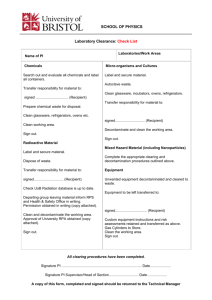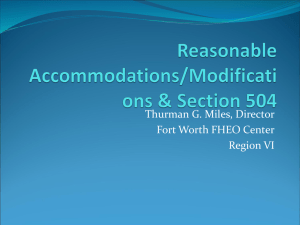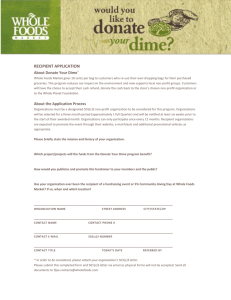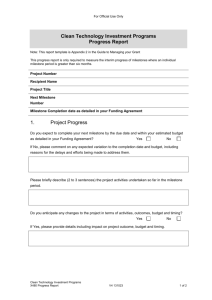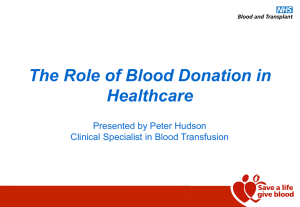Risk Assessment Form for Genetically Modified Micro
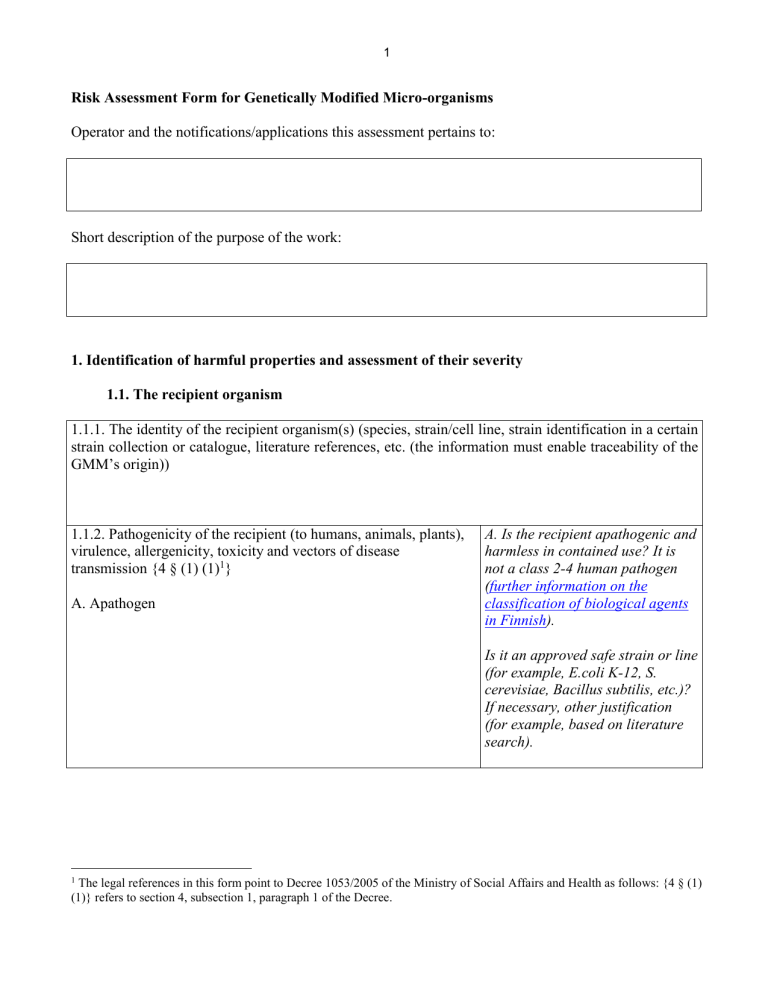
1
Risk Assessment Form for Genetically Modified Micro-organisms
Operator and the notifications/applications this assessment pertains to:
Short description of the purpose of the work:
1. Identification of harmful properties and assessment of their severity
1.1. The recipient organism
1.1.1. The identity of the recipient organism(s) (species, strain/cell line, strain identification in a certain strain collection or catalogue, literature references, etc. (the information must enable traceability of the
GMM’s origin))
1.1.2. Pathogenicity of the recipient (to humans, animals, plants), virulence, allergenicity, toxicity and vectors of disease transmission {4 § (1) (1)
1
}
A. Apathogen
A. Is the recipient apathogenic and harmless in contained use? It is not a class 2-4 human pathogen
( further information on the classification of biological agents in Finnish ).
Is it an approved safe strain or line
(for example, E.coli K-12, S. cerevisiae, Bacillus subtilis, etc.)?
If necessary, other justification
(for example, based on literature search).
1 The legal references in this form point to Decree 1053/2005 of the Ministry of Social Affairs and Health as follows: {4 § (1)
(1)} refers to section 4, subsection 1, paragraph 1 of the Decree.
2
B. Pathogen B. Is the recipient a pathogen?
- what kind of diseases does it cause?
- which toxins or allergens does it produce?
- how is it disseminated, taking into account disease transmitting vectors, such as insects and other animals?
- what is its antibiotic sensitivity like?
- are there available vaccines and treatments for the disease and do the antibiotic resistances affect them?
- is the recipient organism viable outside a human host and is it biologically stable?
1.1.3. Host range of a pathogenic recipient {4 § (1) (5)} Infectivity to humans and animal species susceptible to infection.
Can they (particularly experimental animals) act as disease transmitting vectors?
Multiplication of the pathogen in cell cultures.
Are some groups of people especially susceptible, such as children, old people or immunoincompetent persons?
Plant and animal pathogens are reviewed similarly.
1.1.4. Natural habitat and geographic distribution of the recipient {4 § (1) (7)} (This regards mainly plant and animal pathogens and soil microbes.)
3
1.1.5. Indigenous vectors and adventitious agents of the recipient
{4 § (1) (2)}
1.1.6. Disabling mutations, if any, and their stability. Any prior genetic modifications {4 § (1) (3) and (4)} and their effects (for example, a literature reference).
Are there in the recipient any agents such as plasmids or prophages that may enhance the transfer of genetic material; or in the cell lines, are there any microorganism contaminations, such as bacteria, fungi, mycoplasmas, viruses, parasites or prions?
Describe the mutations potentially weakening the pathogenicity or the viability of the recipient and how the weakened pathogenicity has been verified (for example, alteration in the infective dose).
Is the reversion of the disabling mutations possible, for example, through recombination, complementation or mutations?
1.1.7. Ability to form survival structures (such as spores or sclerotia) {4 § (1) (10)}
1.1.8. Other significant physiological traits that may be altered in the final GMM {4 § (1) (6)}
1.1.9. Possible interaction with, and effects on, other organisms in the environment (including competitive, pathogenic or symbiotic properties) {4 § (1) (9)}
1.1.10. Significant involvement in environmental processes (such as cycling of substances, pH regulation, biodegradation, weathering) {4 § (1) (8)}
1.1.11. The risk class of the recipient (1,2, 3 or 4) based on the information above (for human pathogens the basis is the classification of biological agents ( further information in Finnish )
1.2. The Donor Organism
1.2.1. The donor organism of the transferred genetic material
4
1.2.2. Nature of pathogenicity and virulence of the donor, infectivity, toxicity and disease transmitting vectors {4 § (2) (1)}
1.2.3. Host range of the donor organism {4 § (2) (3)}
1.2.4. Nature of indigenous vectors of the donor (including sequence, frequency of mobilisation and specificity, presence of genes which confer resistance to anti-microbials) {4 § (2) (2) (a)-
(c)}
1.2.5. Other relevant physiological traits of the donor {4 § (2) (4)}
1.3. The Insert
1.3.1. Specific identity and function of the insert (genes) and expression products and their function {4 § (3) (1)}, effect on the activity of the recipient genes {4 § (3) (5)}
1.3.2. Expression of the insert genes {4 § (3) (2)}
The properties of the donor organism should be covered if the sequence of the transferred DNA or/and the properties encoded by it are not precisely known (for example, in the case of a
“shotgun” experiment or in a corresponding case) or if a cell fusion is in question.
Which proteins or regulators do the insert genes encode?
Can this have consequences that increase the harmfulness of the recipient (toxins, allergens, increase in pathogenicity, oncogenes, effect on growth)?
Describe particularly the effects on the properties of the recipient organism, such as inserts affecting pathogenicity and virulence: for example, host specificity, adhesion, avoidance of the host immune system and viability.
If the properties of the gene product are not known, what is the expected function like, for example, on the basis of homologies?
If the insert causes expression of harmful properties (1.3.), describe the conditions necessary for the expression, the level of expression and its effect on the host cell.
5
1.4. The Vector
1.4.1. Nature and source of the vector. The identity of the vector (reference or other description) and its type (cloning vector, expression vector, viral vector, etc.) {4 § (4) (1)}
1.4.2. Structure and amount of any vector nucleic acid remaining in the final construction of the GMM {4 § (4) (2)}
Take particularly into account antibiotic-resistance genes.
1.4.3. If the vector is present in the final GMM construction, what is its capability for transfer of genetic material like and what is its frequency of mobilisation? {4 § (4) (3)}
1.5. The resulting GMM
1.5.1. Human health considerations
1.5.1.1. Comparison of the GMM and its metabolic products to the recipient organism regarding pathogenicity, allergenicity and toxicity {4 § (5) (1) (a) and (b)}
1.5.1.2. Expected capacity for colonisation {4 § (5) (1) (c)}
How does the resulting GMM differ from the recipient?
Has the insert affected the properties of the recipient referred to in 1.1.2. and 1.1.3. or has it introduced any new (harmful) properties?
Has any harmful property been removed?
Mention also possible antibioticresistances.
Are there any alterations in the properties referred to in 1.1.3.?
1.5.1.3. If the GMM is pathogenic to humans, define its ability to cause disease {4 § (5) (2) (a)-(i)}
Are there any alterations in the properties referred to in 1.1.2. and
1.1.3.?
6
1.5.2. Environmental considerations
1.5.2.1. Environments and ecosystems to which the GMM could be unintentionally released {4 § (5) (3) (a)}
1.5.2.2. Expected survivability, multiplication and extent of dissemination of the GMM in the identified environments {4 § (5)
(3) (b)}
1.5.2.3. Anticipated interactions between the GMMs released unintentionally into the environment and the other organisms
(micro-organisms, plants and animals) in the environment {4§ (5)
(3) (c) and (d)}
Take into account in the environments, in addition to the nearest work areas, the other indoor spaces, waste management and sewer network.
Take also into account dissemination via airborne route and insects.
Are there any alterations in the properties referred to in 1.1.4.,
1.1.5. or 1.1.7.?
Has the insert caused any alterations in the properties referred to in 1.1.9.?
Take also into account the possible consequences of the transfer of the genetic material of the insert into other organisms (particularly antibiotic resistance).
Take into account the effect on such organisms (particularly cell cultures) that may be unintentionally contaminated with the GMM.
Particularly with the genetically modified viruses and viral vectors: take into account the possibility that in addition to the vector the host cell would also be infected by another (possibly contaminating) virus.
Take particularly into account plant and animal pathogens.
7
1.5.2.4. Expected involvement in environmental processes and effects on the physical environment (such as changes in the physical and chemical properties or the ecological balance of the environment) {4 § (5) (3) (e) and 9 § (3) (4)}
Are there any alterations in the properties referred to in 1.1.10.?
2. The initial classification of the GMM starting from the class of risk (1-4) of the recipient defined in 1.1.11. and taking into account 1.2.-1.5. {5 §}
The class of use: 1 2
Further information on the classification
3 4
3. Assessment of possibility of harmful effects occurring
The possibility of the abovementioned harmful effects is assessed taking into account the nature and scale of the operation and the actual protection measures (for example, training of the personnel, premises, equipment, measures regarding the prevention and testing of contamination). In addition, particular attention shall be paid to the disposal of waste and effluents. {6 §}
3.1. The containment and other protection measures in use corresponding to the initial classification of the organism.
Level of containment: 1 2 3 4
Assess if the containment and protection measures meet the minimum conditions referred to in the Decree 1053/2005 of the
Ministry of Social Affairs and
Health. When assessing this, the special characteristics of the
GMM and of the use shall be taken into account.
8
3.2. Nature of the activities to be undertaken {7 §} Assess the risks related to your own use of the GMM. Particularly note all activities that include the possibility of spilling and the generation of aerosols.
Take into account the additional risks caused by sharp objects.
Mention non-routine procedures and specific risks possibly related to the handling of produced proteins.
3.3. Scale of the operation including the density and the volume of the culture and the frequency of repetition of the process {8 §}
3.4. Culture conditions, containment measures and other safety measures (such as vessels and equipment) {9 §}
Physical, biological (for example, auxotrophic mutants) and chemical containment measures
(for example, the used disinfectants).
How are fault situations (such as breaking of vessels) prepared for?
3.5. Environment and ecosystems likely to be exposed when taking into account the scale of the activity and the presence of susceptible species in these environments {9 § (1) and (2)}
3.6. Possibility of occurrence of effects on the physical environment {9 § (4)}
9
4. Determination of final classification taking into consideration the characteristics of the operation
When all potentially harmful characteristics have been reviewed for their severity and possibility of occurrence, and the sufficiency of the containment and protection measures of the initial classification has been assessed, the final classification and containment measures for the genetically modified microorganisms can be determined.
4.1. Determination of the final classification and the final containment measures {10 §}
The class of use:
1 2 3 4
4.2. Confirmation of adequacy of final containment measures.
Once the proposed final classification and containment measures have been determined, the level of human and environmental exposure should be reassessed. This should confirm that the possibility of any harmful effects occurring, taking into account the nature and scale of the work and the proposed containment measures, is acceptably low. When this has been done, the risk assessment has been completed.
Date
Signature
5. References

